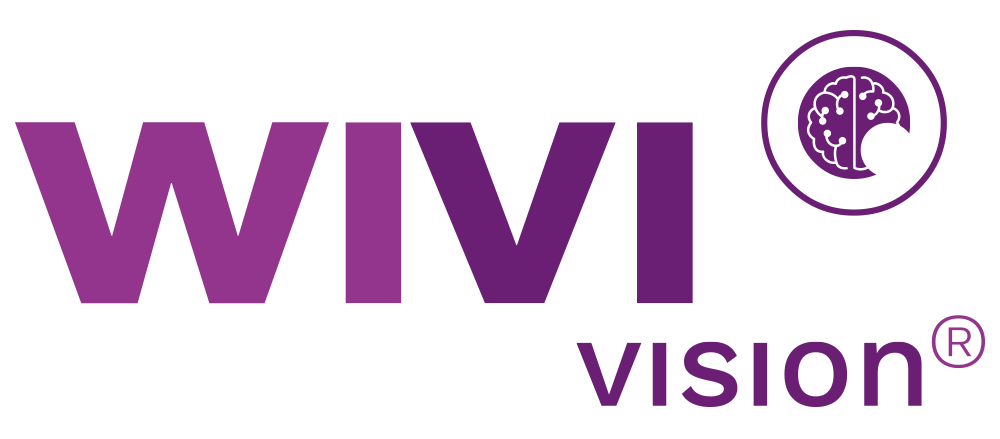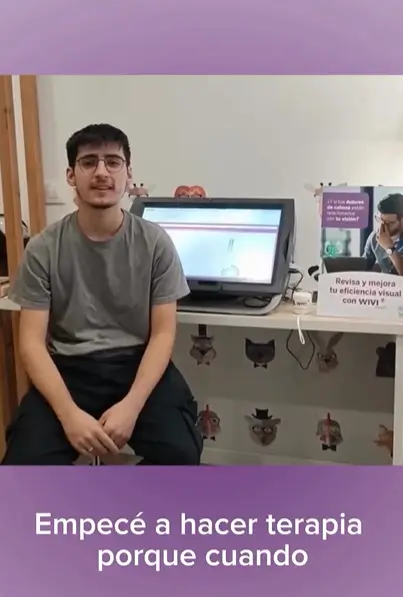Improve visual efficiency with WIVI
- Symptoms
How can WIVI help you?
WIVI assesses your visual efficiency in 10 minutes and helps you improve it in less than 3 months with visual training through immersive, personalized 3D video games.
#PlayWithWIVI


Review and improve visual efficiency with WIVI
WIVI Vision helps to solve all these symptoms in adults and children #PlayWithWIVI

Difficulty Concentrating

Reading Problems

Trouble Focusing

Headaches and Migraines

Blurred Vision
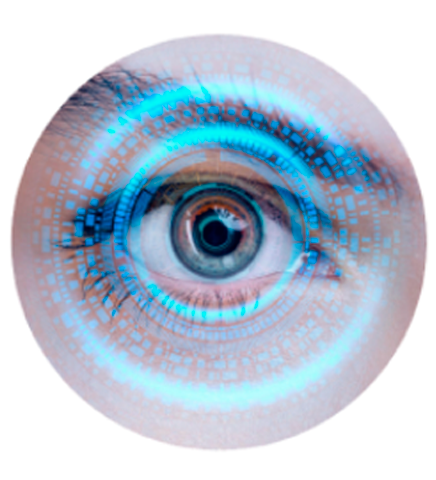
Shaky Vision

Vertigo
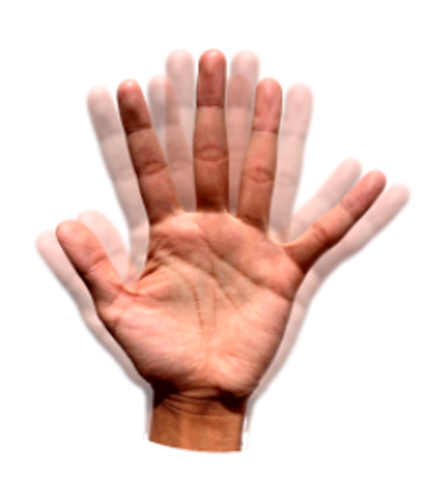
Double Vision

Dizziness

School Performance Problems

Skipping Lines When Reading

Visual Fatigue
Live the WIVI experience!
Discover how taking care of your visual efficiency can change your life.
Start your journey with WIVI
Improve your vision in 5 easy steps!
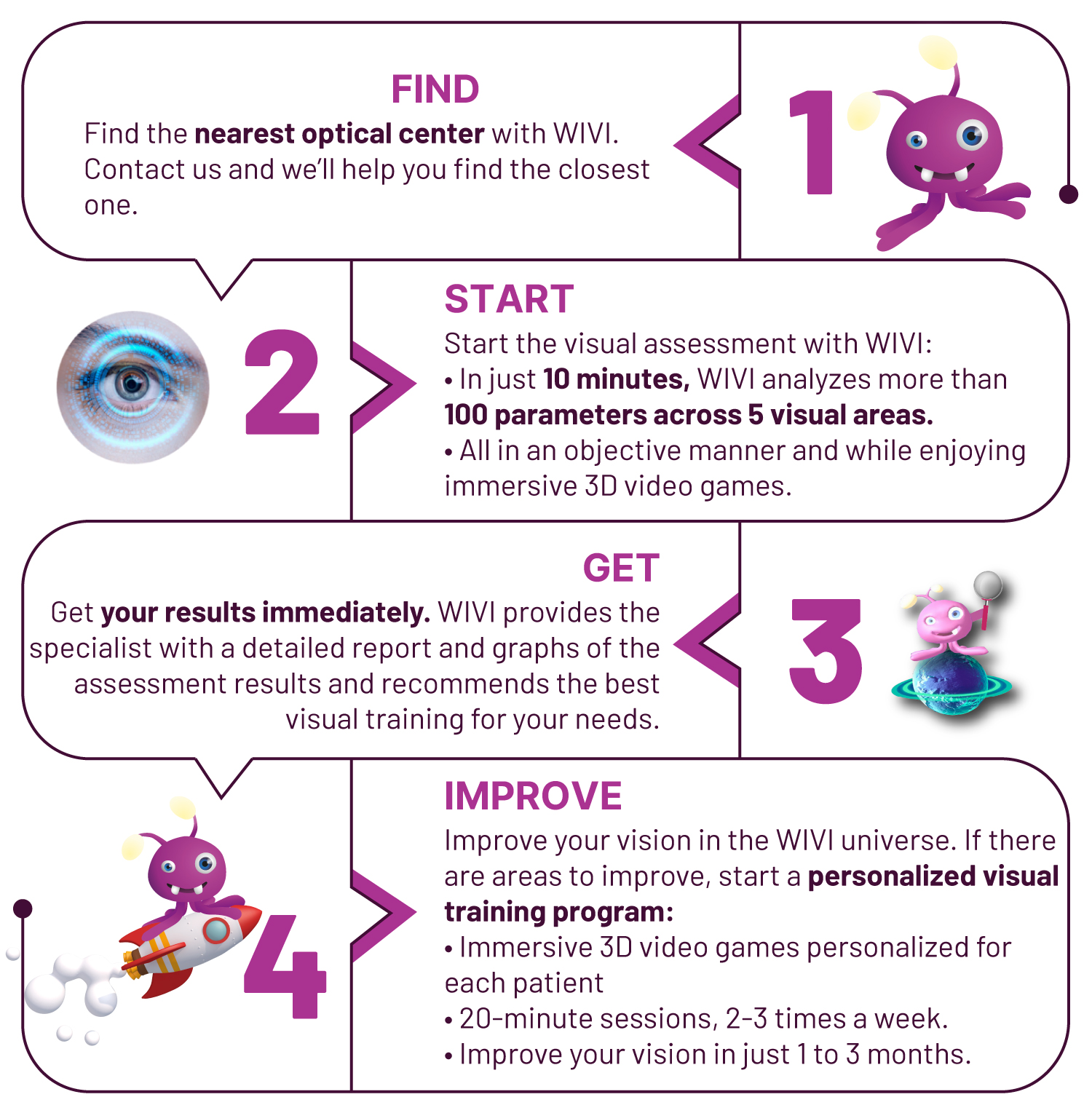
Dysfunctions
Symptoms:
- Difficulty Shifting Focus: Individuals may experience challenges when trying to shift their focus from near to distant objects, often noticing that it takes longer than usual for distant objects to become clear.
- Blurred Distance Vision: After engaging in prolonged near tasks, distant objects may appear blurry due to the eyes’ reluctance to relax their focus.
- Eye Strain and Headaches: The constant overuse of the focusing muscles can lead to significant eye strain and headaches, predominantly after or during extensive periods of near work.
- Near Work Discomfort: Despite being a condition of excessive near focusing, individuals may also find sustained near tasks uncomfortable due to the strain of over-accommodation.
Symptoms:
- Difficulty with Transitioning Focus: Individuals may experience challenges when shifting their gaze from near to distant objects, or vice versa, often noticing that it takes longer for objects to come into clear focus.
- Blurred Vision: Transient blurred vision can occur when changing the viewing distance due to the delay in the accommodative response.
- Eye Strain and Discomfort: The effort required to focus on objects at different distances can lead to significant eye strain, discomfort, and sometimes headaches, particularly after prolonged periods of work involving changing focus distances.
- Avoidance of Activities Requiring Changing Focus: Due to the discomfort associated with shifting focus, individuals may avoid tasks that require this visual demand, potentially impacting academic or occupational performance.
Symptoms:
- Difficulty with Near Vision: Individuals with this condition may find it challenging to focus on close tasks, affecting reading, writing, and computer work.
- Blurred Vision: Close objects may appear blurry, especially after prolonged periods of near work, as the eyes struggle to maintain focus.
- Eye Strain and Headaches: The effort required to focus on near tasks can lead to significant eye strain and headaches, often described as occurring after or during close work.
- Avoidance of Near Work: Due to the discomfort associated with close tasks, individuals, especially children, may avoid activities that require sustained near focus, potentially impacting academic performance.
Symptoms:
Symptoms are often less severe than those of convergence insufficiency, although they share similar characteristics and are associated with near work. The most common complaints include:
- Headache.
- Drowsiness and visual asthenopia.
- Occasionally, patients report diplopia and/or blurred vision.
In some cases, there is a complete absence of symptoms, which may be due to:
- Binocular suppression developed by the patient to avoid discomfort.
- Avoidance of near visual tasks.
- A high fatigue perception threshold, or monocular occlusion during reading.
Symptoms:
The symptoms that accompany reading or other near work tasks include:
- Visual fatigue.
- Headaches.
- Occasional blurred vision and/or diplopia.
- Ocular strain and drowsiness during study-related activities.
Symptoms:
- Double Vision: The primary symptom is seeing two images of a single object. The duplication can be horizontal, vertical, or diagonal.
- Misalignment of Eyes: In binocular diplopia, the eyes may appear visibly misaligned, either crossing inwards (esotropia) or drifting outward (exotropia) or vertically (hyper or hypotropia).
- Difficulty with Depth Perception: Double vision can significantly impact one’s ability to judge distances, affecting tasks like driving, reading, or walking.
- Visual Discomfort: Individuals with diplopia may experience strain or pain in the eyes as they attempt to focus, leading to headaches and general discomfort.
- Nausea and Dizziness: The confusion between the images can cause symptoms of nausea and dizziness, particularly in severe cases.
Symptoms
- Reading difficulties, such as skipping lines or words, using a finger to guide the eyes, or reading slowly.
- Visual fatigue during prolonged near tasks.
- Poor visual attention.
- Headaches after visually demanding activities.
- Low academic or professional performance related to reading and writing.
Symptoms
Most symptoms are associated with reading and near-vision tasks, including working with computers or mobile devices. Patients commonly report:
- Visual fatigue
- Headaches
- Occasional blurred vision
- Loss of concentration
There may also be non-specific symptoms related to sudden changes in the vergence system. All of these issues could be due to the strain caused by several hours of continuous work at close distances, focusing on a two-dimensional plane without taking breaks to rest.
When taking the patient’s history and asking about aspects related to visual hygiene, they often report working distances and postures that are completely inadequate.
Symptoms:
The symptoms of vertical dysfunction are often not constant.
There may be hours or even days without any noticeable symptoms, which can later appear suddenly. Symptoms may include:
- Dizziness
- Headaches that vary in intensity, from a mild discomfort behind the eyes to pounding pain in the temples
- Neck or back pain, possibly due to compensatory torticollis
- Migraines
- Pressure or a heavy sensation on the crown of the head, similar to sinus pain
- A feeling of unsteadiness while walking or difficulty walking in a straight line
- Nausea
- Pain when moving the eyes
- Poor hand-eye coordination
- Disorientation due to excessive visual stimuli
- Difficulty driving
Frequently Answers and Questions
Where can I try WIVI?
WIVI is available in optical centers and specialized clinics with optometrists. Contact us, and we’ll help you find the nearest center.
Is there a minimum or maximum age to use WIVI?
WIVI is designed for all ages, from 7 to 99 years old.
Do I need to have vision problems to use WIVI?
We recommend that everyone checks their visual efficiency. WIVI helps improve vision for people with or without dysfunctions.
What is the visual assessment with WIVI like?
The assessment with WIVI is fast and fun: in just 10 minutes, WIVI analyzes your vision while you play immersive, personalized 3D video games. At the end, WIVI generates a detailed report for your specialist and recommends the necessary visual training for your case.
What does the visual training with WIVI involve?
The visual training with WIVI lasts between 1 and 3 months, depending on each case, with sessions of just 20 minutes. Like the assessment, it is done by playing immersive 3D video games designed to improve your vision in a personalized way.
What visual symptoms does WIVI address?
With WIVI, you can improve blurry vision, double vision, headaches, reading difficulties, and low academic or work performance.
Why is it called WIVI?
WIVI comes from combining WIDE (WI) and VISION (VI), representing our mission to encompass the full scope of our vision.
Would you like to try WIVI?
Find the nearest center and take the first step towards better eye health. It’s easy and within your reach!
